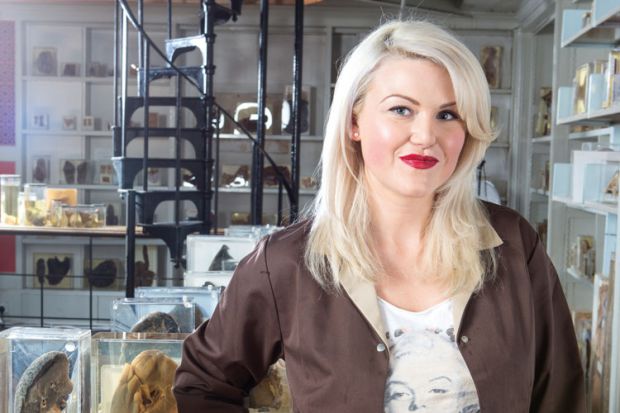Source: Gemma Day
Carla Valentine is technical curator of Barts Pathology Museum, part of the School of Medicine and Dentistry at Queen Mary University of London. She is a fully qualified anatomical pathology technician and worked in a mortuary for eight years conducting post-mortem examinations. She vlogs about the specimens on YouTube, under the name The Chick and the Dead.
Where and when were you born?
In Mossley Hill, Liverpool, in 1981.
What drew you to the world of corpses and pathology?
That’s difficult to say because it was something I was always interested in – I was never interested in another career from the age of about eight. Initially I wanted to be a scientist, then as I reached the age of about 10 it developed into pathology. I was fascinated by biology and forensic science and when my friends were reading Enid Blyton books I was reading forensic casebooks and lots of Sherlock Holmes and Agatha Christie.
You describe Barts Pathology Museum as a “medical humanities” hub. Do you believe that death is an interdisciplinary academic subject area?
Yes – there are many different facets to death and not just the scientific definition, but the pathology museum isn’t just about death anyway. Some of the specimens come from people who remained alive – for example they may have had their feet removed because of gangrene caused by living on the streets, or had their hair and scalp ripped off by dangerous Victorian machinery. They therefore tell important stories about socioeconomic aspects of disease, occupational history and law.
What is it about the macabre that makes us so fascinated with it?
I’m certainly not an expert and I can’t answer this definitively but I find it interesting that as society’s interaction with death and human remains in a positive way decreases, there seems to be an exponential increase in “gore” via other media such as television or computer games. It’s as though, as a species, we have a need to witness some aspects of death to appreciate our own mortality but now that is being removed from us (ie, we don’t lay out our own dead any more, and there are issues surrounding the viewing of medical specimens etc) we instead create our own gore and become more fascinated with the macabre because it’s now considered taboo.
Do you ever get creeped out by the specimens in the museum or does your passion and curiosity for an artefact override any horror you may feel?
I think if I was to ever feel creeped out by these specimens I would have been in the wrong job my entire life. I’ve never felt awkward or sickened by anything or anyone, such as the deceased I used to work with in mortuaries or any of the specimens I work with now. At least death is a natural part of life – I’m more creeped out by unnatural things, like Gogglebox or Red Bull!
What keeps you awake at night?
Nothing! I exhaust myself at the gym and wake up every morning at 5.30am so when my head hits that pillow, I’m out like a light.
Have you ever had a eureka moment?
Yes – when I realised it would be a good idea to create a networking and dating site for those in the death industry, so I did. It’s called Dead Meet and I use it to find research partners, people to lecture or present at the museum and much more. It now has thousands of members.
What was your university experience like?
Quite serious – I’d previously taken a year out to be an embalmer’s assistant so by the time I got to university [Liverpool John Moores] I was very focused on my studies. I did forensic and biomolecular sciences there and had only one full day off a week (which I spent working in a quality assurance lab) and one afternoon off which I spent volunteering in the local mortuary!
What advice would you give to your younger self?
Keep doing what you’re doing – you’re on the right path.
What are the best and worst things about your job?
I think the worst thing is having to continually justify the need for public engagement with pathology (as opposed to only those in related industries) and walk a very fine line between being interesting and “offensive” as both terms are very subjective. The best thing is being in such a wonderful, historical environment which inspires my creativity every day and puts me in contact with fantastic people of a similar mindset.
Given the grisly specimens on display, do you tend to get more visitors to the museum at your Halloween events?
I wouldn’t say we receive more visitors because our events always sell out, but I certainly do organise a lot more events clustered around Halloween. This is not because I consider the venue spooky, although I’m sure that many people, not used to human specimens, certainly would. It’s more because this is the time of year we naturally consider the dead, and Halloween (the Celtic Festival of Samhain) is traditionally one of the dates at which the veil between the living and the dead is at its thinnest. It therefore seems fitting for me to pay homage to the collection and the deceased it represents at the same time as our ancestors would and at the same time as those in other countries (such as Mexico) do.
Register to continue
Why register?
- Registration is free and only takes a moment
- Once registered, you can read 3 articles a month
- Sign up for our newsletter
Subscribe
Or subscribe for unlimited access to:
- Unlimited access to news, views, insights & reviews
- Digital editions
- Digital access to THE’s university and college rankings analysis
Already registered or a current subscriber? Login

